I wasn’t going to buy this book. As much as I like Gail Marsh’s previous books – 18th Century Embroidery Techniques and 19th Century Embroidery Techniques – her latest book, Early 20th Century Embroidery Techniques, sort of fell off the radar. I didn’t think it would interest me that much.
But on a whim one day, I ordered the book, and then I duly forgot about it. When it arrived in the post, I set it aside for a day. I barely even looked at it. And then …. then it happened! I picked it up, and I started reading it….
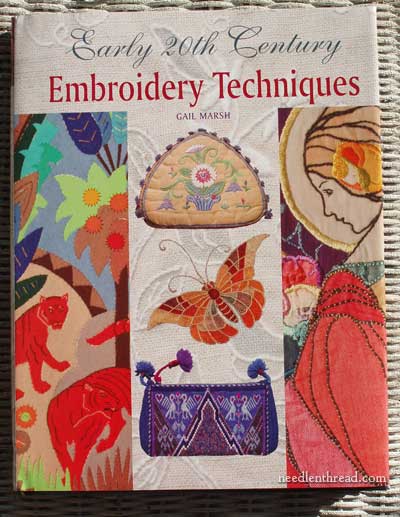
…. and I couldn’t put it down until I had finished it, from cover to cover.
Now, between you and me and the dog, I have a little secret. I don’t generally read a whole needlework book from cover-to-cover, every caption, every side note, every stitch description. When I do, it’s a rare thing. Normally, I introduce myself to the book by flipping through the book and reading the things that catch my attention. If I’m going to write a thorough review – and especially if I think I might have trouble giving a thoroughly objective review – I make myself read the book and really pay attention to it. But I don’t always read everything in it.
But this book was different. I didn’t know what it was going to be about. The title doesn’t really expose what the book is truly about. I’d say that, more than anything else, this book is a story book. It’s a story of passion. It’s a story of survival and revival.
And of course, there’s plenty of technical instruction in it, too.
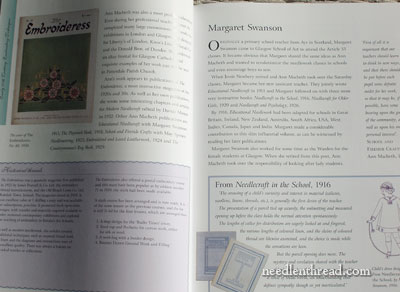
Gail Marsh, as curator of the Rachel Kay-Shuttleworth Collection at Gawthorpe Hall in Lancashire, England, is perfectly positioned to write this book. The RKSC is one of the largest collections of historical needlework in the UK. According to their website, Gawthorpe Hall houses about 27,000 items in their collection. In addition to being the safeguard of so many examples of historical needlework, the RKSC is also a teaching resource. That is, many items in the collection are available to be studied in a hands-on, examination-type way.
Within the collection are many samples from embroiderers of the early 20th century in England. Many of these embroiderers were connected in some way to each other, primarily through the arts movement of the era. And thanks to these needleworkers, the art of embroidery was revitalized, so that it could survive for future generations (that’s us!).
What Marsh does in the book is take the key movers-and-shakers in the needlework world at the time (along with some obscure but notable ones) and present carefully researched, brief biographies, highlighting their work in the textile world, examining their needlework styles and techniques, demonstrating their drive to teach embroidery and to preserve it, and detailing how each of these key figures were connected to each other in one way or another. She draws a fascinating picture of characters who were wholly dedicated to the art of embroidery and to its survival and revival.
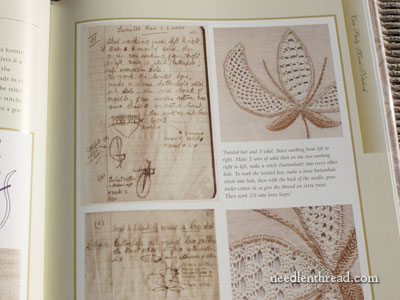
The book includes many close-up photos of pieces in the RBKS Collection, and in some cases, these are accompanied by the embroiderer’s own notes. Of the three books in Marsh’s books on eras of embroidery, in fact, this one is the largest book, with the most numerous photos.
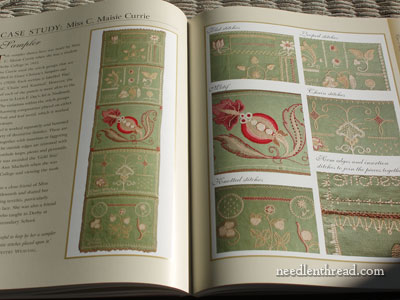
The book is divided into eight sections, and within those sections, the author examines the characters of the revival movement, from those initially connected with the Glasgow School of Art, to those who were influenced in some way by the Glasgow School or by those connected to the school, to those who eventually built notable collections of needlework. Besides biographical information, Marsh provides samples of the embroiderer’s work, discusses design & technique influences, and then highlights the different techniques through stitch instructions and technical advice.
Throughout the book, you’ll find several “case studies,” where Marsh takes on a particular item or set of items on display, and examines them closely, explaining them in context of the embroiderer’s art.
The book is really well arranged.
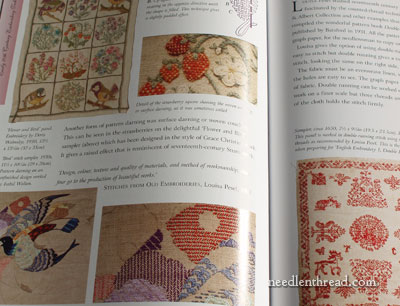
Take time to linger over the photos of these works! Studying them slowly, you will learn much from them and find inspiration in them. The captions for the photos are all well-worth reading, too, as are the highlighted excerpts from the artists themselves.
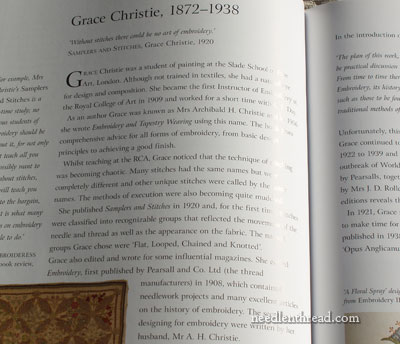
Yes, there’s a section on Grace Christie (who published under the name of Mrs. Archibald Christie). She wrote (among many other things) Samplers & Stitches – which you’ll find online for free through various sources. It’s definitely worth reading. She was also key in studying and cataloging and organizing stitch terminology, which had gotten quite out of hand by her day.
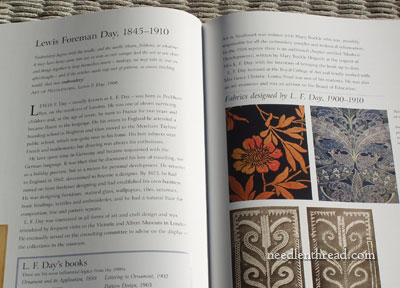
There’s also a section on Lewis Foreman Day, who wrote (among other things) Art in Needlework (which is available on Project Gutenberg, and well worth downloading).
You’ll find out about the “cottage industries” that grew from this revival movement, and you’ll see how schools of needlework came to be. You’ll discover how needlework – home “industry” – helped women and girls, the poor, and the home-bound in this era.
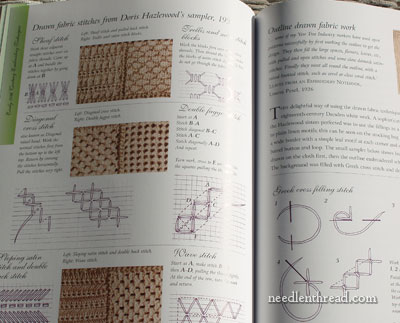
You can see here that the instructional content in the book is quite nice. Next to photos of examples, you’ll find drawn diagrams that work out the method of stitching for you.
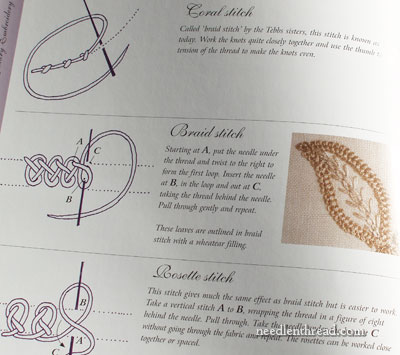
And there are numerous stitches illustrated, stitch-dictionary style, throughout the book.
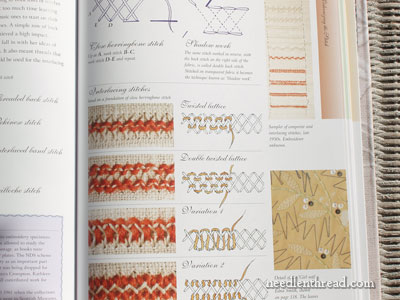
During this era, the stitch itself was a primary focus – so you will see plenty of stitch exploration throughout the book.
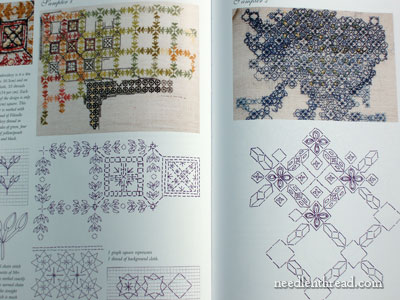
You’ll see what influenced the various embroiderers of the day. From 17th century blackwork, to the embroidery of Greece, to Casalguidi embroidery from Italy – there are so many connections! You’ll see the emergence of Wessex Stitchery from the hands of Mrs. Margaret Foster (and you’ll also be able to see the back of her work, for those of you who are ever curious about the back side of embroidery!).
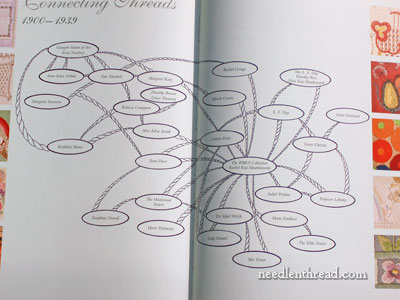
Best of all, you’ll see a story unfold – a story of the “connecting threads” in the revival and survival of the art of embroidery. The final section of the book is very brief – it’s called “Connecting Threads.” You’ll see, as Gail Marsh puts it, how “all these people connect together and influence one another as friends, teachers, and pupils.” She’s got a terrific chart here that connects each of the characters of her study. It’s cleverly done.
The whole book will show you how and why embroidery was considered an art worthy of careful study and preservation; you’ll see innovations in embroidery; you’ll discover people like yourselves, for whom needlework was their passion. And you’ll develop a great appreciation for the dedication of these individuals to preserving and passing on the art of embroidery.
It’s just an excellent book, and certainly one of those “happy purchases.” I am glad I bought it!
And how much do you want to bet that I’ll read it again?
Where to Find
You can find 18th Century Embroidery Techniques through the following book affiliates:
In the US: Early 20th Century Embroidery Techniques at Amazon
Worldwide:: Early 20th Century Embroidery Techniques through Book Depository with free worldwide shipping.







Hello Mary,
Thank you for your informations about this book.
I find it very interesting.
So, do you tell me wher I can buy it.
Thank for your response.
Congratulations for your site I find it very, very, very interesting.
Have a nice day.
OK, you got me. I’m headed for Amazon to purchase a copy. YOU are very bad for my budget, but great for my happiness.
Thanks Marymentor <3
While I can't afford to buy all the books you review/present, I'm so grateful for the peek into them. And I'm also grateful that (having found by looking reeeeel closely with my 71 year old eyes), I could read the words BRAID STITCH on one of the pages, I know that somewhere in your blog/site/whatever (still can't tell which is which with these things) that I will find your step by step explanation of how to do this BRAID STITCH. In a word, whatever I run across regardless of where it is, I know that Marymentor, somewhere, will show me how to do it ! …love the way they used it to edge a leaf….and love this site
I'll bet you and Perry Como get "stacks and stacks of letters"….but you're too young to remember that ! :-)…..thanks again
Judy in Pittsburgh
That little cosmic screech you just heard is my checkbook whimpering at adding yet another book to the list based on your review.
Thanks for the review! I’ve read her 18th century embroidery book cover to cover many times, even though I’m just like you-I don’t usually read a needlework book cover to cover. It’s just so well written and engaging and she writes with such love and passion about the subject, I’m very curious to read this book too-of which I didn’t even know the existence!
this book is great as the other 2 for that matter! I love me a lot and often refers !!!!!
I love your review of this Embroidery technique book! My hands don’t work like they used to, but I so enjoy looking and learning!
Many, many thanks, Mary for this terrific review and for the links! I will be looking at them all. And yes, I’m one of those who likes to see the back of embroidery! I’m a “forensic vintage embroidery collector” or perhaps “detective” is a better word, who enjoys figuring out how stitches were done in my vintage collection!
Blessings!
Laurie
Laurie — I love to look at the backs as well. I think it’s important, though I’ve heard experienced embroiderers/designers say things like “it’s nobody’s business what the back looks like.” Maybe not, but it does effect the front. Good for you.
I’m glad to know I’m not the only one that reads embroidery books cover to cover! Oddly enough, I’d much rather read about embroidery than read a novel. This one sounds like another I will be adding to my wish list.
G’day there Mary, this is wonderful. Thank you.
Cheers, Kath.
I bought this book as it was published. I think it should be nominated for an award, it works on so many levels.
I was fortunate enough to go to the Burrell Collection, Glasgow for one of their Hands On sessions, laid out before us were the samples for the book that Ann Macbeth co-authored. It describes a programme for the teaching of needlework in Schools in 1911 and went worldwide within a very few years.
The Rachel Kay Shuttleworth collection is well worth a visit and Gail Marsh’s research is meticulous.
Oh boy, are you going to be in trouble Mary! I couldn’t resist this one either and now it is on its way to me and the Chancellor of the Exchequer (aka husband) doesn’t even know.
Isn’t the internet wonderful – you write about a book, I like the sound of it, click on a couple of websites, find the cheapest deal and voila! the book is on its way and I haven’t even got out of bed.
I try to collect stitch dictionary type books; I am fascinated with different stitches and all their varying names and since there is at least some of that in this one I think I am going to looooove it.
Thank you.
Thank you again Mary. You are doing a fantastic job. I’ve just bought it with the last book you just reviewed “the fine linen”. I’m giving lecture about embroidery and your reviews are a great ressource for me. Thank you very much.
Hi Mary. As I told you, I bought it with the two others after I read your post. I have to say that I’m not so enthusiastic about it as I’m about the two first. I think it is because I’m not so keen in the embroidery work made during this period.
All three great books.
Meticulous research, comprehensive explanations
and excellent photography.
How lucky I was to have Gail as one of my C&G Tutors in the 70’S. She was a star even then.
Betty.
I am always a day late and a dollar short. I fell upon this book very recently, and was posting it on Good Reads when I found a link posting to your review. You are right, it is a page turner and very exciting to me, as an ex-pat living in Scotland, with a strong interest in all textile arts, but most especially needlework. The Glasgow School of Art burned last year, which is awful, but it has led to a huge re-vitalisation of all things related to it, and especially to the Glasgow Four. So this is the long way round to say that my favourite part of this book was that it was about the women, and it showed the before and after of the Rennie Mackintosh influences. Thank you Mary!